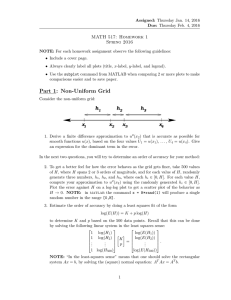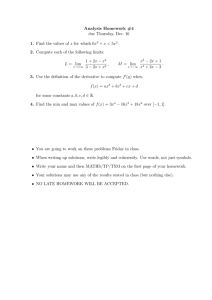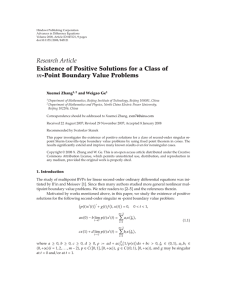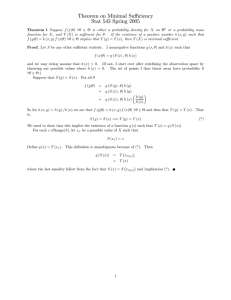POSITIVE SOLUTIONS OF SECOND-ORDER SINGULAR BOUNDARY VALUE PROBLEM WITH A LAPLACE-LIKE OPERATOR
advertisement
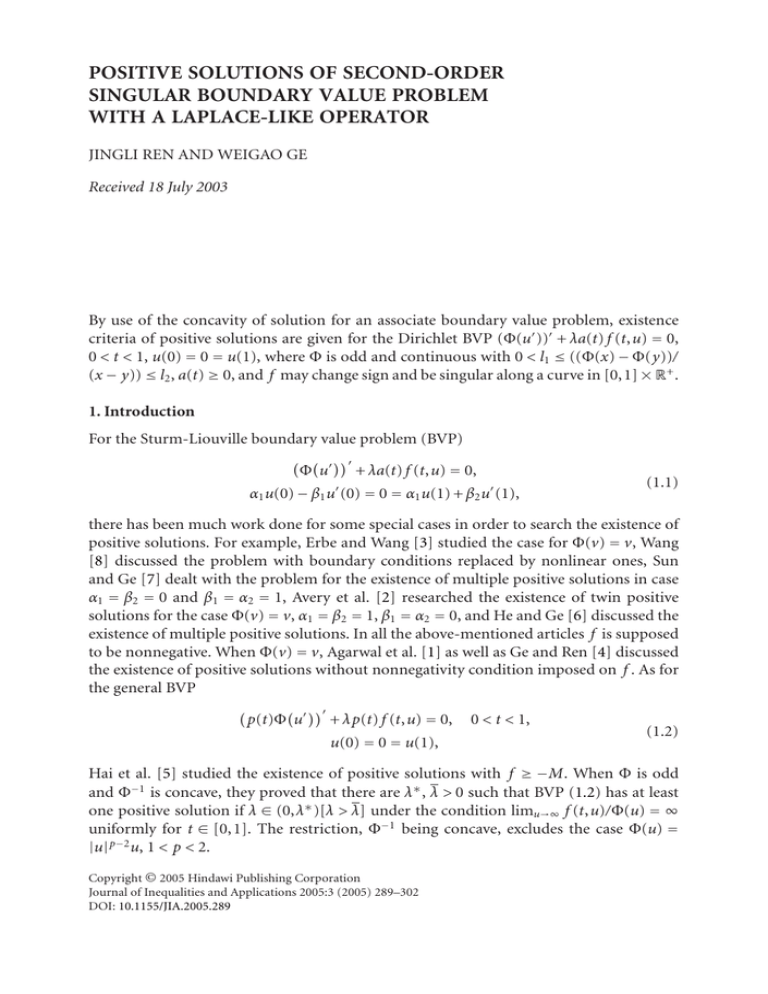
POSITIVE SOLUTIONS OF SECOND-ORDER
SINGULAR BOUNDARY VALUE PROBLEM
WITH A LAPLACE-LIKE OPERATOR
JINGLI REN AND WEIGAO GE
Received 18 July 2003
By use of the concavity of solution for an associate boundary value problem, existence
criteria of positive solutions are given for the Dirichlet BVP (Φ(u )) + λa(t) f (t,u) = 0,
0 < t < 1, u(0) = 0 = u(1), where Φ is odd and continuous with 0 < l1 ≤ ((Φ(x) − Φ(y))/
(x − y)) ≤ l2 , a(t) ≥ 0, and f may change sign and be singular along a curve in [0,1] × R+ .
1. Introduction
For the Sturm-Liouville boundary value problem (BVP)
Φ u
+ λa(t) f (t,u) = 0,
α1 u(0) − β1 u (0) = 0 = α1 u(1) + β2 u (1),
(1.1)
there has been much work done for some special cases in order to search the existence of
positive solutions. For example, Erbe and Wang [3] studied the case for Φ(v) = v, Wang
[8] discussed the problem with boundary conditions replaced by nonlinear ones, Sun
and Ge [7] dealt with the problem for the existence of multiple positive solutions in case
α1 = β2 = 0 and β1 = α2 = 1, Avery et al. [2] researched the existence of twin positive
solutions for the case Φ(v) = v, α1 = β2 = 1, β1 = α2 = 0, and He and Ge [6] discussed the
existence of multiple positive solutions. In all the above-mentioned articles f is supposed
to be nonnegative. When Φ(v) = v, Agarwal et al. [1] as well as Ge and Ren [4] discussed
the existence of positive solutions without nonnegativity condition imposed on f . As for
the general BVP
p(t)Φ u
+ λp(t) f (t,u) = 0,
u(0) = 0 = u(1),
0 < t < 1,
(1.2)
Hai et al. [5] studied the existence of positive solutions with f ≥ −M. When Φ is odd
and Φ−1 is concave, they proved that there are λ∗ , λ > 0 such that BVP (1.2) has at least
one positive solution if λ ∈ (0,λ∗ )[λ > λ] under the condition limu→∞ f (t,u)/Φ(u) = ∞
uniformly for t ∈ [0,1]. The restriction, Φ−1 being concave, excludes the case Φ(u) =
|u| p−2 u, 1 < p < 2.
Copyright © 2005 Hindawi Publishing Corporation
Journal of Inequalities and Applications 2005:3 (2005) 289–302
DOI: 10.1155/JIA.2005.289
290
Singular BVP with a Laplace-like operator
In this paper, we want to give theorems for the existence of positive solutions for the
BVP
Φ u
+ λa(t) f (t,u) = 0,
0 < t < 1, λ > 0,
u(0) = 0 = u(1),
(1.3)
without the restriction f (t,u) ≥ −M for (t,u) ∈ [0,1] × R+ and without Φ−1 being concave.
We suppose throughout this paper that
1−δ
1
(H1) a ∈ C((0,1), R+ ) and for a δ ∈ (0,(1/2)), 0 < δ a(t)dt ≤ 0 a(t)dt < ∞;
(H2) Φ is odd, continuous with
0 < l1 ≤
Φ(x) − Φ(y)
≤ l 2 < ∞,
x−y
x = y.
(1.4)
Obviously (H2) implies that Φ−1 (s) exists and
Φ−1 (x) − Φ−1 (y) 1
1
≤ < ∞,
0< ≤
l2
x−y
l1
x = y.
(1.5)
2. Preliminary lemmas
Lemma 2.1. Suppose (H1)-(H2) hold. Then for λM ∈ R,
Φ u
+ λa(t)M = 0,
0 < t < 1,
(2.1)
u(0) = 0 = u(1)
has a unique solution
wλM (t) =
t
0
Φ−1 λM c −
s
0
a(τ)dτ
ds
(2.2)
with c satisfying
1
0
Φ−1 λM c −
s
0
a(τ)dτ
ds = 0.
(2.3)
Proof. It is easy to show that u = w(t) is a solution to BVP (2.1) if and only if u(t) is expressed in (2.2) with c satisfying (2.3). Now we show that there is only one c which makes
1
hold. Without loss of generality, we suppose λM ≥ 0. Let H(c) = 0 Φ−1 (λM(c −
(2.3)
s
0 a(τ)dτ))ds. Then H : R → R is continuous and strictly increasing with
1
H(0) < 0 < H
which implies there is a unique c0 ∈ (0,
1
0
0
a(τ)dτ ,
a(τ)dτ) such that H(c0 ) = 0.
(2.4)
J. Ren and W. Ge 291
It follows that there is σ ∗ ∈ (0,1) such that c0 =
wλM (t) =
Remark 2.2. Let k0 = (1/l1 )
1
0
t
0
Φ−1 λM
σ∗
0
a(τ)dτ and then (2.2) becomes
σ∗
s
a(τ)dτ ds.
(2.5)
a(τ)dτ. It follows from (2.5) that
1
wλM = max wλM (t) ≤ |λM |
1
a(τ)dτ ≤ |λM |k0 ,
l1 0
1
w = max w (t) ≤ |λM | 1
a(τ)dτ = |λM |k0 .
λM
λM
0≤t ≤1
l1 0
0≤t ≤1
(2.6)
Remark 2.3. It is easy to see that
w−λM (t) = −wλM (t),
w
w−λM = wλM ,
−λM
= w ,
λM
(2.7)
(t)) is nonincreasing when λM ≥ 0.
and Φ(wλM
Lemma 2.4. uλ (t) and wλM (t) are solutions of BVP (1.3) and BVP (2.1), respectively, with
f replaced by f ∗ ∈ C([0,1] × R, R). Let
D = (t,x) ∈ (0,1) × − ∞,wλM (t) .
(2.8)
If f ∗ (t,x) ≥ M(≤ M) holds for each (t,x) ∈ D, then
uλ (t) ≥ wλM (t)
uλ (t) ≤ wλM (t) ,
t ∈ [0,1].
(2.9)
Proof. We prove only the case f ∗ (t,x) ≥ M.
Suppose the contrary. Then there is t0 ∈ (0,1) such that (t0 ,uλ (t0 )),(t0 ,wλM (t0 )) ∈ D
(t0 ) ≤ 0. The
and uλ (t0 ) − wλM (t0 ) < 0. Without loss of generality we assume uλ (t0 ) − wλM
condition uλ (1) = wλM (1) = 0 implies there is t1 ∈ (t0 ,1] such that
uλ (t) < wλM (t),
t ∈ t0 ,t1 ;
uλ t1 = wλM t1 .
(2.10)
Then for t ∈ (t0 ,t1 ),
(t)
Φ uλ (t) − Φ wλM
t0 − λ
= Φ uλ t0 − Φ wλM
≤ Φ uλ t0 − Φ wλM t0 ≤ 0,
t
t0
a(τ) f ∗ τ,uλ (τ) − M dτ
(2.11)
292
Singular BVP with a Laplace-like operator
(t) which implies
and therefore uλ (t) ≤ wλM
t1
uλ t1 − wλM t1 = uλ t0 ) − wλM t0 +
t0
uλ (s) − wλM
(s) ds < 0,
(2.12)
a contradiction to (2.10).
Remark 2.5. If f (t,x) ≥ M(≤ M) is replaced by f (t,x) > M(< M), then uλ (t) > wλM (t)
(uλ (t) < wλM (t)).
Lemma 2.6. Suppose u, v ∈ C 1 ([0,1], R+ ) and u(0) = u(1) = v(0) = v(1) = 0. If u ≥
v and u is concave, then
u(t) ≥ v(t),
t ∈ [0,1].
(2.13)
Proof. Suppose there is σ ∈ (0,1) such that u(σ) = u = L. Then v(t) ≤ Lmin{t,1 − t },
t ∈ [0,1]. The concavity of u implies u(t) ≥ u(σ)min{t,1 − t }. So u(t) ≥ v(t) holds for
t ∈ [0,1].
For each x ∈ C([0,1], R), f ∗ ∈ C([0,1] × R, R), the solution to
Φ u
+ λa(t) f ∗ t,x(t) = 0,
0 < t < 1,
(2.14)
u(0) = 0 = u(1)
can be expressed in the form
u(t) =
t
0
Φ −1 λ c −
s
0
a(τ) f ∗ τ,x(τ) dτ
ds
(2.15)
with c satisfying
1
0
Since H(c) =
and
1
0
Φ
−1
Φ−1 (λ(c −
λ c−
s
0 a(τ) f
∗
s
0
a(τ) f
∗
ds = 0.
τ,x(τ) dτ
(2.16)
(τ,x(τ))dτ))ds is strictly increasing with respect to c
t
H(c) < 0 when c < min
0≤t ≤1 0
t
H(c) > 0 when c > max
0≤t ≤1 0
a(τ) f ∗ τ,x(τ) dτ,
a(τ) f
∗
(2.17)
τ,x(τ) dτ,
there is only one cx ∈ R,
t
min
0≤t ≤1 0
a(τ) f ∗ τ,x(τ) dτ < cx < max
t
0≤t ≤1 0
a(τ) f ∗ τ,x(τ) dτ
(2.18)
J. Ren and W. Ge 293
such that H(cx ) = 0. So the solution
σ to BVP (2.14) is unique. At the same time, (2.18) implies there is σx ∈ (0,1) such that 0 x a(τ) f ∗ (τ,x(τ))dτ = cx . Then (2.15) can be written
as
u(t) =
t
σx
Φ −1 λ
0
s
a(τ) f ∗ τ,x(τ) dτ ds.
(2.19)
Furthermore, by u(1) = 0 and for t ≥ σx ,
u(t) = −
=
and therefore
t
1
t
0
s
Φ −1 λ
Φ
−1
s
λ
σx
σx
a(τ) f ∗ τ,x(τ) dτ ds
a(τ) f
∗
τ,x(τ) dτ ds,
t
σx
∗
Φ −1 λ
a(τ)
f
τ,x(τ)
dτ
ds,
0
s
u(t) = 1
s
Φ −1 λ
a(τ) f ∗ τ,x(τ) dτ ds,
t
for each σx ∈ Σx = {σ ∈ [0,1] :
σ
0
(2.20)
0 ≤ t ≤ σx ,
(2.21)
σx ≤ t ≤ 1
σx
a(τ) f ∗ (τ,x(τ))dτ = cx }.
Lemma 2.7. The constant c = cx determined by (2.16) is continuous with respect to x ∈
C([0,1], R).
Proof. Suppose the contrary. Then there are xn ∈ C([0,1], R) which converge to x(t) uniformly in [0,1] and cn , determined by (2.16) with x replaced by xn , converging to c0 = cx .
Applying Lebesgue’s dominating convergence theorem, we have
1
0
as n → ∞ in
1
0
Φ−1 λ c0 −
Φ−1 λ cn −
s
0
s
a(τ) f ∗ τ,x(τ) dτ
a(τ) f ∗ τ,xn (τ) dτ
0
ds = 0
(2.22)
ds = 0.
(2.23)
The uniqueness of solution to (2.16) implies c0 = cx , a contradiction.
Take X = C([0,1], R) and define
T : X −→ X
(2.24)
by
(Tx)(t) =
t
0
Φ−1 λ cx −
s
0
a(τ) f ∗ τ,x(τ) dτ
ds
(2.25)
with cx satisfying
1
0
Φ−1 λ cx −
s
0
a(τ) f ∗ τ,x(τ) dτ
ds = 0,
(2.26)
294
Singular BVP with a Laplace-like operator
or equivalently,
t
σx
−1
∗
λ
a(τ) f τ,x(τ) dτ ds,
Φ
0
s
(Tx)(t) = 1
s
−1
∗
Φ
λ
a(τ)
f
τ,x(τ)
dτ
ds,
t
0 ≤ t ≤ σx ,
(2.27)
σx ≤ t ≤ 1,
σx
where σx ∈ Σx . Obviously u(t) = (Tx)(t) is the solution of (2.14).
Lemma 2.8. T : X → X is completely continuous.
Proof. Because Φ−1 , f are both continuous, a(t) is integrable on (0,1), and cx is continuous with respect to x, it is easy to show that T is continuous in X. Given a bounded set
Ω ⊂ X, (2.25) implies TΩ is bounded. Differentiating (2.25) with respect to t, one has
(Tx) (t) = Φ−1 λ cx −
t
0
a(τ) f ∗ τ,x(τ) dτ
.
(2.28)
Obviously there is L > 0 independent of individual x ∈ Ω such that
(Tx) (t) ≤ L,
x ∈ Ω, t ∈ [0,1]
(2.29)
which implies TΩ is equicontinuous. Then the complete continuity of T : X → X follows
from the Arzela-Ascoli theorem.
Now we define furthermore
T ∗ : X −→ X
(2.30)
by
T ∗ x (t) = wλM
(t) + T x − wλM
(t),
(2.31)
is an arbitrary constant.
where M
From Lemma 2.8 the following result holds.
Lemma 2.9. T ∗ : X → X is completely continuous.
Obviously, u(t) = x(t) − wλM
(t) is a solution to BVP (1.3) if and only if x is a fixed
point of T ∗ : X → X.
3. Main results
cc
1s
= (l2 /l1 )M, let A = (1/l1 )max0≤c≤1 [ 0 s a(τ)dτ ds + c c a(τ)dτ ds], let B = (1/l2 )
Let M
cc
1−δ s
δ1
1
min
c a(τ)dτ ds], and let d = (M/l1 )[ 0 s a(τ)dτ ds + 1−δ
s δ ≤c≤1−δ [ δ s a(τ)dτ ds + c
0 a(τ)dτ ds], where M > 0 is a constant. Condition (H1) implies A,B > 0.
Let also X = C([0,1], R) with the norm · defined by u = max0≤t≤1 |u(t)|, and
K = {u ∈ X : u(t) ≥ 0 is concave on [0,1]}. Then K is a cone in Banach space X.
J. Ren and W. Ge 295
Suppose in addition
(H3) f (t,u) ≥ −M is continuous for (t,u) ∈ [0,1] × [wα (t), ∞), where α, M > 0 are
two constants.
Then let
f (t,u),
f (t,u) = f t,wα (t) ,
∗
u ≥ wα (t),
u < wα (t).
(3.1)
Clearly f ∗ (t,u) ≥ −M is continuous on [0,1] × R.
Define T ∗ : K → K as (2.31).
Lemma 3.1. T ∗ (K) ⊂ K.
Proof. For y ∈ K,
T ∗ y = wλM
(t) + T y − wλM
(t),
(3.2)
where wλM
and T(y − wλM
) satisfy, respectively, (2.1) and (2.14). Applying Lemma 2.4 we
get from f ∗ (t,(y − wλM
)(t)) ≥ −M ≥ −(l2 /l1 )M = −M that
T y − wλM
(t) ≥ w−λM
(t) = −wλM
(t),
0 ≤ t ≤ 1,
(3.3)
and hence
T ∗ y (t) ≥ 0,
0 ≤ t ≤ 1.
(3.4)
At the same time, for t1 ,t2 ∈ [0,1], t1 < t2 ,
T∗ y
t2 − T ∗ y
t1
t2 − T y − wλM
t1 + wλ M
= T y − wλM
t2 − wλM
t1
σ
−1
∗
λ a(τ) f τ, y − wλM
=Φ
(τ) dτ
t2
σ
− Φ −1 λ
+ Φ −1
t1
a(τ) f
λM
σ0
t2
∗
(3.5)
τ, y − wλM
(τ) dτ
a(τ)dτ − Φ−1
λM
σ0
t1
a(τ)dτ .
Since
Φ −1
λM
σ0
t2
a(τ)dτ − Φ−1
λM
σ0
t1
1 a(τ)dτ ≤ − λM
l2
t2
t1
a(τ)dτ ≤ 0,
(3.6)
one has
T∗ y
t2 − T ∗ y
t1 ≤ 0
(3.7)
296
Singular BVP with a Laplace-like operator
if
t2
a(τ) f ∗ τ, y − wλM
(τ) dτ ≥ 0.
t1
(3.8)
On the other hand, when
t2
a(τ) f ∗ τ, y − wλM
(τ) dτ < 0,
t1
(3.9)
it follows that
Φ
−1
σ
λ
∗
a(τ) f
t2
1
l1
≤− λ
t2
t1
τ, y − wλM
(τ) dτ − Φ
−1
σ
λ
a(τ) f ∗ τ, y − wλM
(τ) dτ ≤
t1
a(τ) f
1
λM
l1
∗
τ, y − wλM
(τ) dτ
t2
a(τ)dτ,
t1
(3.10)
and then
T∗ y
t2 − T ∗ y
t1 ≤
1
λM
l1
t2
t1
a(τ)dτ −
1 λM
l2
t2
t1
a(τ)dτ = 0.
(3.11)
Then (T ∗ y)(t) is concave. So T ∗ K ⊂ K.
Lemma 2.9 and Lemma 3.1 imply that T ∗ : K → K is completely continuous.
Theorem 3.2. Suppose (H1), (H2), and (H3) hold and
(H4) f (t,wα (t)) ≥ αa(t), t ∈ (0,1),
0 and c ∈ (2Mk
0 ,2b) such that
(H5) there are b > Mk
0
c − 2Mk
,
A
f (t,u) <
(t,u) ∈ [0,1] × wα (t),b .
(3.12)
Then BVP (1.3) has at least a positive solution u = u(t) with
u + w
λM
< b,
u(t) ≥ wα (t),
t ∈ [0,1],
(3.13)
if λ ∈ [1,(2b/c)].
Proof. Take Kb = {x ∈ K : x < b}. Then Kb is a closed convex set in X. Each y ∈ ∂Kb ,
T ∗ y (t) ≤ wλM
(t) +
0+
≤ λMk
t
0
t
Φ
0
σ
Φ −1 λ
−1
σ
λ
s
s
a(τ) f ∗ τ, y − wλM
(τ) dτ ds
a(τ) f
∗
(3.14)
τ, y − wλM
(τ) dτ ds,
where σ is taken from Σ y−wλM such that
T y − wλM
(σ) = max T y − wλM
(t).
0≤t ≤1
(3.15)
J. Ren and W. Ge 297
It follows from (2.27) that
0 1 σ σ
λ c − 2Mk
a(τ)dτ ds,
A
l1 0 s
0 1 1s
∗ λ c − 2Mk
T y (t) ≤ λMk0 +
a(τ)dτ ds,
A
l1 σ σ
0+
T ∗ y (t) ≤ λMk
(3.16)
then
σ
σ
0 1
λ c − 2Mk
2A
l1 0
λ c − 2Mk0
λc
0+
< λMk
= .
2
2
0+
T ∗ y (t) ≤ λMk
s
1s
a(τ)dτ ds +
σ
σ
a(τ)dτ ds
(3.17)
When λ ≤ (2b/c), we have
∗ T y < b = y .
(3.18)
Hence T ∗ has a fixed point y = y(t) in Kb . Obviously u = y − wλM
is a solution to
BVP (2.14). When λ ≥ 1, one has λ f ∗ (t,x) ≥ αa(t), (t,x) ∈ [0,1] × (−∞,wα (t)]. And
Lemma 2.4 implies u(t) ≥ wα (t), 0 ≤ t ≤ 1. So u(t) is also a solution to BVP (1.3).
Corollary 3.3. In Theorem 3.2 if (H5) is replaced by
(H5) limu→+∞ (( f (t,u))/u) = 0 uniformly in t ∈ [0,1],
then BVP (1.3) has at least one solution u = u(t) with
u(t) ≥ wα (t),
u < ∞
(3.19)
when λ ≥ 1.
0 /εA)
Proof. For λ ∈ [1, ∞), take ε ∈ (0,(1/λA)). Then (H5) implies there is b > (2Mk
such that
f (t,u)
<ε
b
for (t,u) ∈ [0,1] × wα (t),b ,
(3.20)
that is,
f (t,u) < εb =
0
c − 2Mk
A
for (t,u) ∈ [0,1] × wα (t),b ,
(3.21)
0 + εbA. Applying Theorem 3.2, we see that BVP (1.3) has a positive soluwhere c = 2Mk
0 + bεA)) = (2b/c).
tion u(t) ≥ wα (t) since λ ≤ (1/εA) = (2b/2bεA) < (2b/(2Mk
Theorem 3.4. Suppose (H1), (H2), and (H3) hold and in addition
} and c ∈ (4Mk
0 ,2b) such that
(H6) there are b > 2k0 max{α, M
f (t,u) <
0
c − 2Mk
,
A
(t,u) ∈ [0,1] × [wα (t),b],
(3.22)
298
Singular BVP with a Laplace-like operator
(H7) there are a > δa > b and r > (ac/b) such that
f (t,u) >
r +d
,
B
2b Mk0 ,a .
c
(t,u) ∈ [0,1] × δa −
(3.23)
Then BVP (1.3) has a solution u = v(t) with
b < v + wλM
<a
v(t) > wα (t),
(3.24)
when λ ∈ [(2a/r),(2b/c)].
Proof. It can be shown as in the proof of Theorem 3.2 that for y ∈ ∂Kb , we have
∗ T y < y ,
2b
λ ∈ 0,
.
c
(3.25)
For y ∈ ∂Ka , the concavity of y implies
y(t) ≥ aδ,
y − wλM
(t) ≥ aδ −
2b Mk0 , t ∈ [δ,1 − δ]
c
(3.26)
for 0 < λ ≤ (2b/c). Take σ which satisfies (3.15).
(A) σ ∈ [δ,1 − δ].
By use of expressions (2.27) and (2.31), we get
∗ T y > T y − w
=
≥
σ
0
σ
δ
−
λM
(σ)
σ
Φ −1 λ
s
σ
Φ −1 λ
δ
0
s
∗ λ(r + d)
T y >
l2 B
σσ
δ
a(τ) f ∗ τ, y − wλM
(τ) dτ ds
Φ −1 λ M
λ(r + d)
>
l2 B
a(τ) f ∗ τ, y − wλM
(τ) dτ ds
s
σ
s
(3.27)
λM
a(τ)dτ ds −
l1
1−δ s
σ
a(τ)dτ ds
σ
a(τ)dτ ds −
δσ
λM
l1
0
s
a(τ)dτ ds,
1 s
1−δ σ
a(τ)dτ ds.
It follows that
2T ∗ y > λ(r + d) − λd = λr,
∗ T y > a = y for λ ≥ 2a .
r
(B) σ ∈ (0,δ) ∪ (1 − δ,1).
(3.28)
(3.29)
J. Ren and W. Ge 299
Without loss of generality we suppose σ ∈ (0,δ). Then
∗ λ(r + d)
T y >
1−δ s
a(τ)dτ ds −
l2 B
δ
δ
> λ(r + d) − λd = λr,
∗ T y > 2a > a for λ ≥ 2a .
r
1 s
λM
l1
1−δ σ
a(τ)dτ ds
(3.30)
(3.31)
Expression (3.25), together with (3.29) or (3.31), implies T ∗ has a fixed point y, b <
y < a, when λ ∈ [(2a/r),(2b/c)]. Then v = y − wλM
is a positive solution to BVP (2.14)
and
b
2
2b 2b = αk0 +
Mk0 > αk0 + Mk
0
0
c
4Mk
, λ ∈ 2a , 2b .
≥ wα + wλ M
r c
y > b ≥ αk0 +
(3.32)
Applying Lemma 2.6, we have
y(t) ≥ wα (t) + wλM
(t),
λ∈
2a 2b
,
,
r c
(3.33)
and then
v(t) = y(t) − wλM
(t) ≥ wα (t),
λ∈
2a 2b
,
r c
(3.34)
which implies v(t) is also a positive solution to (1.3) with
v(t) ≥ wα (t),
b < v + wλM
< a.
(3.35)
Corollary 3.5. In Theorem 3.4, if (H7) is replaced by
(H7) limu→+∞ ( f (t,u)/u) = +∞ uniformly in t ∈ [0,1],
then BVP (1.3) has at least a solution u = v(t) with
v(t) ≥ wα (t),
v + w
|v | < ∞,
λM
>b
(3.36)
when λ ∈ (0,(2b/c)].
Proof. For each λ ∈ (0,(2b/c)], take a ε ∈ (0,λ) and a N > (2/εδB). Condition (H7) im 0 /δc) such that for each a ≥ a0 ,
plies there is a0 > (2bMk
f (t,u) ≥ Nu ≥ N δa −
2b Mk0 ,
c
u ∈ δa −
2b Mk0 ,a .
c
(3.37)
300
Singular BVP with a Laplace-like operator
Take a > a0 large enough such that
(2a/ε) + d
2b ,
N δa − Mk
0 >
c
B
2b u ∈ δa − Mk
0 ,a ,
c
(3.38)
then Theorem 3.4 implies BVP (1.3) has a positive solution v(t) when λ ∈ [ε,(2b/c)],
where v(t) ≥ wα (t), b < v + wλM
< ∞.
It is easy to show the following two theorems.
Theorem 3.6. Suppose (H1), (H2), (H3), (H4), (H5), and (H7) hold. Then BVP (1.3) has
at least two positive solutions u(t) and v(t) when λ ∈ [1,(2b/c)], where
α ≤ u + wλM
< b < v + wλM
< ∞.
u(t),v(t) ≥ wα (t),
(3.39)
Theorem 3.7. Suppose (H1), (H2), (H3), (H5) , (H6), and (H7) hold. Then BVP (1.3) has
at least two positive solutions v(t) and u(t), when λ ∈ [(2a/r),(2b/c)], where
b < v + wλM
< a < u + wλM
< ∞.
v(t),u(t) ≥ wα (t),
(3.40)
Remark 3.8. Our theorems can be applied to case that f possesses singularity along a
curve in [0,1] × R+ since no restriction is imposed on f for (t,u) ∈ [0,1] × (0,wα (t)].
Example 3.9. Let a(t) = π 2 sinπt, f (t,x) = (4/(4x + 1 − 2sinπt)), and
u,
|u| ≤
Φ(u) = u 2 + sinπ |u| ,
3u,
3
,
2
3
5
< |u| < ,
2
2
5
|u| ≥ .
2
(3.41)
Then w1 (t) = sinπt is the unique solution of
Φ u
+ π 2 sinπt = 0,
u(0) = 0 = u(1),
4
4
f t,w1 (t) =
≥ > 1 = α.
1 + 2sinπt 3
(3.42)
Clearly limu→∞ ( f (t,u)/u) = limu→∞ (4/(4u2 + u − 2usinπt)) = 0 uniformly. Applying
Corollary 3.3, we conclude that
Φ u
4π 2 sinπt
= 0,
4u + 1 − 2sinπt
u(0) = 0 = u(1)
+λ
(3.43)
J. Ren and W. Ge 301
has at least a positive solution u(t) > sinπt when λ > 1. Since f is singular along with
u = (1/4)(2sinπt − 1) > 1, (1/6) < t < (5/6), no previous result can be applied to obtain
the above conclusion.
Example 3.10. Let a,Φ be the same as those in Example 3.9 and f (t,x) = (x2 /432π 2 ) −
(4/(4x + 1 − 2sinπt)). Then l1 = 1, l2 = 3 and for w1 (t) = sinπt we have k0 = 2π and
f (t,x) > −4,
A = max
x
x
0≤x≤1
0
ds
s
(t,x) ∈ [0,1] × [sinπt, ∞),
π 2 sinπτ dτ +
1
x
s
ds
x
π 2 sinπτ dτ = π.
(3.44)
0 = 120π, b = 144π. It follows that
Take c = 5Mk
0
c − 2Mk
> 48,
A
0
(144π)2
c − 2Mk
f (t,x) <
= 48 <
for (t,x) ∈ [0,1] × w1 (t),b .
2
432π
A
(3.45)
Based on Corollary 3.5, BVP
Φ u
u2
4
−
= 0,
432π 2 4u + 1 − 2sinπt
u(0) = 0 = u(1)
+ λπ 2 sinπt
(3.46)
has at least a positive solution u(t), satisfying u(t) > sinπt for t ∈ (0,1), when λ ≤ (2b/c) =
(12/5).
Acknowledgments
This research is supported by the National Natural Science Foundation of China (Project
no. 10371006) and the Postdoctoral Foundation of China.
References
[1]
[2]
[3]
[4]
[5]
[6]
R. P. Agarwal, H.-L. Hong, and C.-C. Yeh, The existence of positive solutions for the SturmLiouville boundary value problems, Comput. Math. Appl. 35 (1998), no. 9, 89–96.
R. I. Avery, C. J. Chyan, and J. Henderson, Twin solutions of boundary value problems for ordinary differential equations and finite difference equations, Comput. Math. Appl. 42 (2001),
no. 3-5, 695–704.
L. H. Erbe and H. Wang, On the existence of positive solutions of ordinary differential equations,
Proc. Amer. Math. Soc. 120 (1994), no. 3, 743–748.
W. G. Ge and J. Ren, New existence theorems of positive solutions for Sturm-Liouville boundary
value problems, Appl. Math. Comput. 148 (2004), no. 3, 631–644.
D. D. Hai, K. Schmitt, and R. Shivaji, Positive solutions of quasilinear boundary value problems,
J. Math. Anal. Appl. 217 (1998), no. 2, 672–686.
X. He, W. G. Ge, and M. Peng, Multiple positive solutions for one-dimensional p-Laplacian
boundary value problems, Appl. Math. Lett. 15 (2002), no. 8, 937–943.
302
[7]
[8]
Singular BVP with a Laplace-like operator
W. P. Sun and W. G. Ge, The existence of positive solutions for a class of nonlinear boundary value
problems, Acta Math. Sinica 44 (2001), no. 4, 577–580 (Chinese).
J. Wang, The existence of positive solutions for the one-dimensional p-Laplacian, Proc. Amer.
Math. Soc. 125 (1997), no. 8, 2275–2283.
Jingli Ren: Institute of Systems Science, Chinese Academy of Sciences, Beijing 100080, China;
Department of Mathematics, Zhengzhou University, Zhengzhou 450052, China
E-mail address: renjl@amss.ac.cn
Weigao Ge: Department of Mathematics, Beijing Institute of Technology, Beijing, 100081, China
E-mail address: gew@bit.edu.cn

